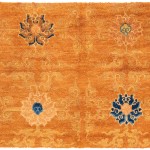Antique Tiffany Carpet Fragment
The only huge carpet known to have left the Imperial Palace in Beijing’s Forbidden City, formerly in the Perenchio collection, is the famous Tiffany carpet, 9.99 metres long and once 9.68 metres wide, but since reduced to 7.20 metres wide. The carpet was originally made in three parts to fit around the columns of an unknown hall, and was reportedly last used in China in the private temple of the Empress Dowager Cixi. It was purchased for Louis Comfort Tiffany of New York, who owned it for more than thirty years. The Tiffany carpet is currently attributed to the end of the Ming dynasty and is thought to have been made in the first part of the 17th century. The field pattern is composed of a repeating design of rows of lotus flowers on a soft beige ground, originally deep red, overlaid in the centre with a medallion formed by a blue line edged in ivory and pinched in the four corners. The field is enclosed by two borders on the same colour, which reappears beyond the borders to create a wide band around the outer edge. The inner border is composed of a lattice of stepped squares filled with a swastika, with a large rosette at each intersection. The outer border is a double version of the swastika fret. A section of the field is shown here, and a few other fragments survive. The Tiffany carpet clearly forms a link between the carpets made during the late 16th century and those made in the late 17th century. Examples with an identical flower design or the same specific ‘heavy’ weave are now referred to as the ‘Tiffany’ type after this most important carpet. Other carpets of this type include one in the Nelson-Atkins Museum in Kansas City and one in the Metropolitan Museum of Art, New York. The Tiffany type form part of the ‘transitional’ group dating from the first half of the 17th century – between the identifiable Wanli carpets and the well known Qing dynasty carpets of the Kangxi era – which represent a number of different workshops or areas of production. It is not known exactly where the Tiffany or the earlier Wanli imperial carpets were made, but they are sufficiently different in wool, colours, weave and details to the later carpets known to have come from Ningxia to make it unlikely that they were also made there. It is possible that they were in fact made in Beijing, in a specific workshop set up to produce them for the Palace. Research is currently taking place in the Palace Museum Library to find out if any documentary evidence survives.
